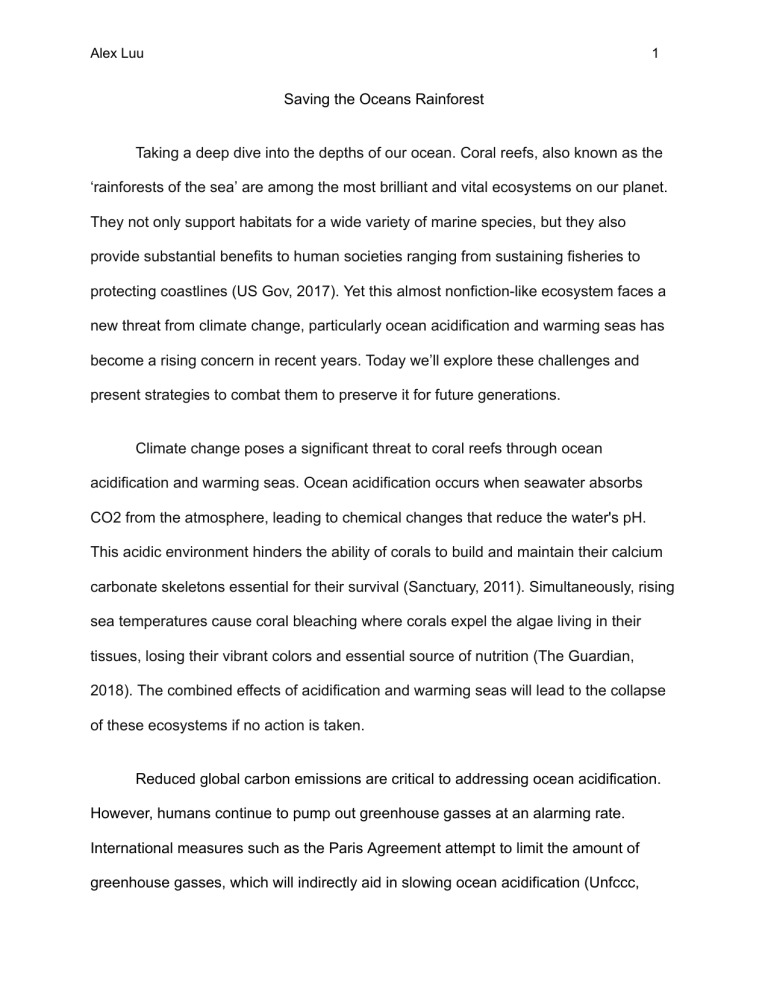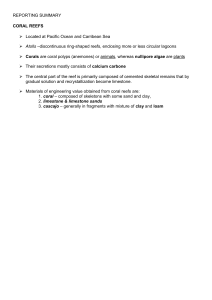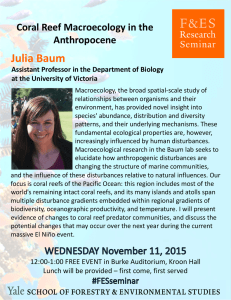
Alex Luu 1 Saving the Oceans Rainforest Taking a deep dive into the depths of our ocean. Coral reefs, also known as the ‘rainforests of the sea’ are among the most brilliant and vital ecosystems on our planet. They not only support habitats for a wide variety of marine species, but they also provide substantial benefits to human societies ranging from sustaining fisheries to protecting coastlines (US Gov, 2017). Yet this almost nonfiction-like ecosystem faces a new threat from climate change, particularly ocean acidification and warming seas has become a rising concern in recent years. Today we’ll explore these challenges and present strategies to combat them to preserve it for future generations. Climate change poses a significant threat to coral reefs through ocean acidification and warming seas. Ocean acidification occurs when seawater absorbs CO2 from the atmosphere, leading to chemical changes that reduce the water's pH. This acidic environment hinders the ability of corals to build and maintain their calcium carbonate skeletons essential for their survival (Sanctuary, 2011). Simultaneously, rising sea temperatures cause coral bleaching where corals expel the algae living in their tissues, losing their vibrant colors and essential source of nutrition (The Guardian, 2018). The combined effects of acidification and warming seas will lead to the collapse of these ecosystems if no action is taken. Reduced global carbon emissions are critical to addressing ocean acidification. However, humans continue to pump out greenhouse gasses at an alarming rate. International measures such as the Paris Agreement attempt to limit the amount of greenhouse gasses, which will indirectly aid in slowing ocean acidification (Unfccc, 2 2015). Besides regulations, adaption solutions such as carbon capture and storage (CCS) technologies provide an immediate method to reduce CO2 levels (National Grid, 2022). This idea has been floating around since the 1970’s and Projects like Norway's Sleipner gas field demonstrate the promise of CCS. This process captures and stores CO2 underground, preventing it from entering the atmosphere and seas (MIT, 2016). Fighting coral reef’s main threat of warming seas necessitates a focus on reducing global warming through renewable energy adoption and conservation. Shifting away from fossil fuels to renewable energy sources like solar and wind will significantly reduce the greenhouse gasses (Unfccc, 2015). The Coral Reefs Conservation Program or NOAA, set zones where human activity is limited and provide refuge for coral reefs to preserve them as much as possible (NOAA, 2007). Moreover, ideas that are floating around are exploring innovative cooling techniques, such as shading corals or developing heat-resistant coral strains which would offer additional measures to aid in this battle (Melbourne, 2020). Effective mitigation requires integrating these solutions, but community involvement is equally crucial. Educating and engaging local populations in conservation efforts is a step towards the sustainable management of coral reefs (USEPA, 2022). The survival of coral reefs amidst climate change relies on our collective actions as a species. By implementing comprehensive strategies ranging from global policy reforms to innovative scientific research and community engagement (USEPA, 2022). There is hope for our vital ecosystems, and It is our responsibility to ensure our grandchildren get to see these underwater marvels. 3 References USA.gov. (2017, April 11). Rainforests of the sea - coral comeback. Coral Comeback| Every Full Moon | Ocean Today. https://oceantoday.noaa.gov/fullmoon-rainforestsofthesea/welcome.html#:~:text=C oral%20reefs%20are%20some%20of,the%20smallest%20of%20all%20%2D%20c orals. Sanctuary, F. K. N. M. (2011, April 4). Coral bleaching and ocean acidification are two climate-related impacts to coral reefs. How is climate change affecting coral reefs? https://floridakeys.noaa.gov/corals/climatethreat.html#:~:text=Ocean%20acidificati on%20slows%20the%20rate,storms%3B%20and%20altered%20ocean%20circula tion. Guardian News and Media. (2018, June 23). Coral reefs “will be overwhelmed by rising oceans.” The Guardian. https://www.theguardian.com/environment/2018/jun/23/coral-reefs-overwhelmed-b y-rising-oceans UNFCCC. (2015, December 12). What is the Paris Agreement? https://unfccc.int/process-and-meetings/the-paris-agreement National Grid. (2022, February 28). What is carbon capture and storage?. CCS explained | National Grid Group. https://www.nationalgrid.com/stories/energy-explained/what-is-ccs-how-does-it-wo rk#:~:text=CCS%20has%20been%20in%20operation,tons%20of%20CO2%20und erground. MIT. (n.d.). As of September 30, 2016, the Carbon Capture and Sequestration Technologies Program at MIT has closed. the website is being kept online as a reference but will not be updated. Carbon Capture and Sequestration Technologies . https://sequestration.mit.edu/tools/projects/sleipner.html#:~:text=It%20is%20estim ated%20that%20the,project%20started%20to%20June%202015. 4 Program, Noaa. C. R. C. (2007, October 12). NOAA’s Coral Reef Conservation Program (CRCP) home page. NOAA Coral Reef Conservation Program (CRCP) Home Page. https://coralreef.noaa.gov/ U of Melbourne. (2020, May 14). Scientists develop “heat resistant” coral to fight bleaching. Newsroom. https://www.unimelb.edu.au/newsroom/news/2020/may/scientists-develop-heat-res istant-coral-to-fight-bleaching#:~:text=The%20team%20isolated%20the%20micro algae,adapt%20and%20survive%20hotter%20conditions. U.S. Environmental Protection Agency. (2022, June 22). What you can do to help protect coral reefs | US EPA. What You Can Do to Help Protect Coral Reefs. https://www.epa.gov/coral-reefs/what-you-can-do-help-protect-coral-reefs




